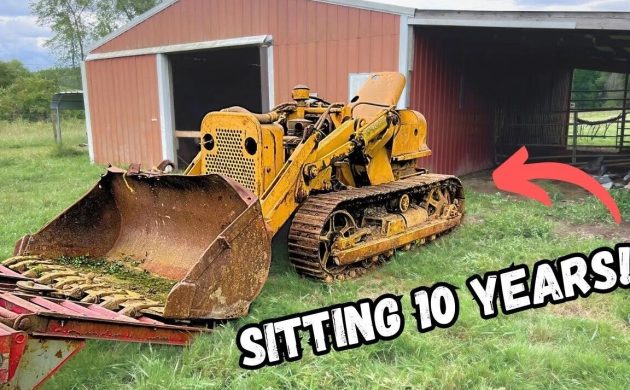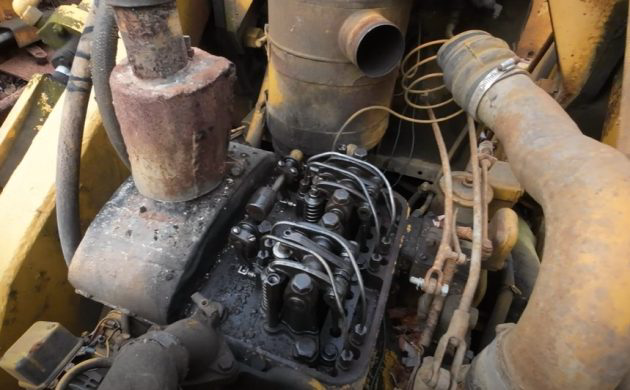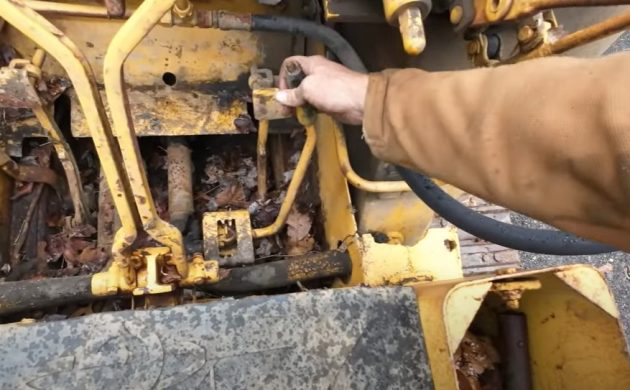Just in time for Christmas, here’s a vintage Allis Chalmers HD5 track loader for sale on eBay, bid to $2605 with no reserve. Think of all the chores you can complete with this baby lurking in your shed – like after my F250 brings the hay home, I can dump it – pronto! – right into the barn! moving gravel will be a breeze! those sacks of Sakrete? no problem! Of course, it doesn’t run perfectly though the seller did a yeoman’s job of resurrecting it from near-death. And presuming you won’t be driving it home (!), there’s the matter of an appropriate trailer. This thing weighs about 15,000 lbs, so don’t be thinkin’ about your old race car trailer. Right now, it’s sitting firmly on terra firma in Bulger, Pennsylvania, and the seller says you can keep it on-site until June 1, 2024.
This model was made between 1948 and 1955. The engine is a 2.3 liter two-cylinder Detroit Diesel 2-71 generating about 30 hp at the drawbar or 48 hp at the belt. The video in the listing shows the seller replacing the injectors, so it starts and runs now. The five-speed sliding gear transmission and master clutch are said to work well, too. It is sold without batteries, however. In top form, the HD5 will reach about 6 mph in fifth, so slow is the name of the game. The seller notes that the right-hand steering clutch isn’t working properly, the loader arms are “sloppy” and its hydraulic cylinders leak a bit (don’t stand under that bucket!). And a prospective buyer should inspect the tracks and their workings minutely – those are not so easy to replace. So that’s your work list.
No, it’s not built for comfort and for most of us, driving it will involve a steep learning curve. Unlike most tractors sold today, there’s no roll bar, or seat belt, and this one needs replacement headlights.
Allis Chalmers no longer exists, but its history stretches back to 1901 when it made blast furnaces, conveyors, and other heavy industry equipment. Its foray into agriculture and construction machinery began in 1914. Today’s equipment makes this little crawler look like a child’s toy, but values are still hanging around the current price or even higher. This site lists recent auction prices of $2200 to $4100 for this model. Wish I had a place to park it!





Cool, only 3 photos?
And an hour-long video embedded in the eBay listing and in a link above in my article. I paused the video to get the engine and interior shots…..
Michelle whats the 0-6 time on this model? 😃
Have had several old Allis crawler loaders and dozers over the years…
Good old machines but some parts are getting harder to get….always stocked up on parts machines when I could find them
Note to author, you done outdid yourself this time. Gee wilikers, where to start? 1st, the excellent writeup on something I don’t ever recall seeing here. 2nd, and as important, who here remembers the childrens book, Katy the Snow Plow? My mom read that to me many times. About a 55hp IH crawler tractor, that in the winter was the town of Geoppolis’ snow plow. Like Mike Mulligans Steam Shovel, the machines had a “can do” attitude, and not much could stop them.
On to this machine. The farm I lived on had a similar tractor, a JD 430 and for a while in the mid-90s, I worked for a cable trencher dealer, as the driver, natch, and operated many of these machines. I can say right now, loading a steel track machine on steel ramps, is not for the faint of heart. When wet, even worse.
Allis Chalmers was the pride of Milwaukee, more accurately, West Allis, a then suburb of Milwaukee. Not far from Milwaukee Mile. A-C employed a lot of people then. Like I always say, Milwaukee was a hummin’ place. I hauled silica sand into A-C. Nothing remains of the factory, a business and hotel district now. These tractors did it all, with one glaring exception here, the 2 cyl, 2 cycle Detroit. :(, good heavens, a Briggs would have more guts,) I read, you could get a 2cycle Detroit in any configuration, from 1 cylinder to 16. I’ve operated many front end loaders for various jobs, and no power is incredibly frustrating. Sometimes can’t even lift a full bucket. I believe this is an early one, 1950(?) many were orange, and newer ones had a longer nose. Hydraulics was the big thing then,, as many bigger dozers were still cable lift. Hydraulics changed everything. Thinking of a job running one? Sounds exciting, no? Um, no, in fact, it’s an incredibly boring job, and gets old might quick. For around the farm, you must have one, and they are simple, but heavy, to fix. I bet parts are still around for these. The motor may be enough to propel the unit with a shovel full in the bucket, but for real work, an update would be best. Great find, and a gold star for the author!
There were a couple of local contractors who used HD5s similar to this one for close to 30 years. One of the operators, Tude, everyone called him (interesting because his name was Clayton), who could comb your hair with his. He used to recruit me to help him out with basements. Hard to believe he dug basements with that loader. I will always remember the exhaust tone that reminded you of a perpetual raspberry fart combined with tearing canvas. But you could always hear the drone of the blower that reminded you it was a Detroit Diesel…
Hey, pal, if this didn’t bring you around, I was going to call the wife. Been my experience, that bucket is way too aggressive for the 2 cylinder motor. Fact is, I’ve seen bigger “pony” motors used to start bigger diesels. Why did they have pony motors, Geo? I mean, from the war, they surely had big enough electric starters. That front piece with the holes, I believe is an aftermarket grille guard, as most of these didn’t have that. Glad you correctly said “operators” and not drivers. You drive a truck, you operate a machine. I read, this was the smallest of the crawler tractors, and it’s missing the valve cover and the tracks look pretty good. I’ve seen some worn swayback tracks on these. Did these even have a blower?
Wait, never mind, I see on some images it did have a blower on the left side. For some that may not know what a blower did, unlike its top fuel cousin, that literally RAMS fuel down the intake, these did just the opposite. It “blew” exhaust gases out of the crankcase, so the next charge fired more efficiently,,,or so I was told. An expansion chamber on gas 2 strokes do about the same thing.
My parents read me both those books and we read them to our kids. Great books and great drawings. I loved the two page spread showing the map of the town and everywhere Katy plowed out.
There is kid near this town in Penn. with a you tube channel by the name of Diesel Creek. He retrieves & gets running again old machinery of all kinds. He has dozens of videos & is very good at producing his content. Amazing his knowledge & diagnostic ability. He has a video working on a Detroit powered machine like this one. I wonder if this is his?
I follow him on Youtube. Awesome videos and stories. That Autocar he got running is a beast.
This is in fact his.
I was almost sure it was. Matt is one heck of a mechanic.
I love those screaming Gemmies. This would make a nice rig assuming it has decent undercarriage. The potential buyer should check the pins and bushings and condition of the track shoes and drive sprockets.
What’s a restored one go for?
Semi functional rusty car crusher that will come in handy for recycling the rusty junk on this site, perfect.
Although it’s a real temptation I have to pass on this regrettably because it doesn’t have power vent windows.
Its a funny thing. An offhand comment like the RH steering clutch isn’t working properly just takes a minute to write, but is not a small thing to fix. All this old stuff pretty much needs to be fixed as a hobby as a days wages for a shop will be higher than the purchase price. And that is if you can find the parts.
And while they are pretty simple to work on, they aren’t easy. Getting into a major part, (or virtually any part like spool valves) can take days and a lot of sub assembly removal. Once removed finding shops that can work on them once out is difficult and repairs can take months.Fixing something as simple as a spool valve can be a 6 month multi thousand dollar project (if it isnt o rings)
I speak from experience as most of my old equipment ( loaders, semis, grader and more) is all from the 50’s to 60s. About 10 years ago it became MUCH harder to find people and shops to work on this stuff. The old timers retired and no one picked up the slack and my reliable shops are closing. The writing is on the wall for keeping my stuff running.
Places like Diesel Creek are few and far between, you pretty much need to be able to fix it yourself.
Oh, Screamiing Jimmys are fun.. For about 10 minutes. My Kenworth has one ( as does my shovel and other rigs) and even with a good exhaust and earmuffs or earplugs, I am worn out after about 2 hours just from the noise.
I sure enjoy these finds though
A pretty good assessment of owning and repairing vintage equipment. One needs a skid steer with forks to lift anything. People may think my views on disappearing interest is half baked, but its nice to hear from someone else. The JD450 on the farm had a profuse oil leak, almost hidden, and just easier to add oil everytime, an environmentalists nightmare. While I joke about 2 cycle Detroits, I have operated machines with bigger Detroits, and did fine. A 2cylinder will barely transport the machine and a poor choice. With a weight of almost 12,000 pounds and scrap $300/ton, sadly, you know where ones that need repair will end up.
One good thing about vintage equipment is no electronic junk, computer garbage or emissions crap to go bad. Just good old iron. You won’t see today’s machines in operable condition on vintage automotive sites 70 years from now.
Unique features like one are in part what makes BF so awesome, thanks Michelle!
My pleasure, I love to write about weird wheel’d stuff.
Howard A, you had it right on the function of the blower on the GM 2-cycle Diesels. It was intended to scavenge the exhaust gases from the cylinder which was done by the piston in a 4-stroke Diesel. Some have erroneously referred to these blowers as ‘superchargers”, but they really didn’t pressurize the cylinder as a true supercharger does. The blower only puts slightly over atmospheric pressure in the cylinder. That said, blowers from two-cycle GM Diesels were popular as superchargers in the 60’s for gasoline-engined hot rods. The GM 2-71 Diesel in the Allis HD5 track loader was rated at about 50 horsepower on the belt, 40 on the drawbar, which would put it in the contemporary Caterpillar D4 class. For those who wanted to compare this engine to “pony” engines, the starting engine on a Cat D8 was rated at about 25 horsepower or about half the power of an HD5 engine.